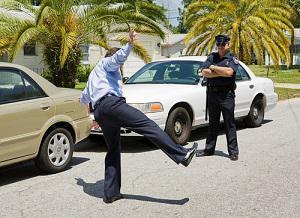Standardized Field Sobriety Tests During a DUI Stop
 Consider, if you will, being pulled over on suspicion of driving under the influence, or DUI. The officer asks if you have been drinking, and whatever answer you give, you are asked to step out of the car and submit chemical and sobriety testing. Based on your own memory, what are some the tests likely to be used? Will you need to recite the alphabet in reverse order? Will you be asked for the third digit of your zip code? While it may be entertaining to think of various methods that could be employed to trip up an intoxicated driver, law enforcement officers generally rely on a series of assessments approved by the National Highway Traffic Safety Administration (NHTSA) known as the Standardized Field Sobriety Test, or SFST.
Consider, if you will, being pulled over on suspicion of driving under the influence, or DUI. The officer asks if you have been drinking, and whatever answer you give, you are asked to step out of the car and submit chemical and sobriety testing. Based on your own memory, what are some the tests likely to be used? Will you need to recite the alphabet in reverse order? Will you be asked for the third digit of your zip code? While it may be entertaining to think of various methods that could be employed to trip up an intoxicated driver, law enforcement officers generally rely on a series of assessments approved by the National Highway Traffic Safety Administration (NHTSA) known as the Standardized Field Sobriety Test, or SFST.
What is Included in the SFST?
The SFST is a battery of three separate designed to help on-the-scene law enforcement estimate a driver's level of intoxication. These tests can be used to complement a chemical testing procedure, such as a breathalyzer, or to provide justification for a DUI arrest in the event the chemical testing is inconclusive or otherwise not available.
You have probably seen or at least heard about each of the three tests that comprise the SFST, as they have been in use for more than 60 years. The SFST includes the:
- Horizontal gaze nystagmus (HGN) test: The subject must follow a slowly-moving object—a pen, flashlight, or the officer's finger—with his or her eyes only. The officer is looking for involuntary jerking of the eyeball, called nystagmus, which is often exaggerated by intoxication.
- Walk-and-turn test: The subject must walk nine steps, heel to toe, on a straight line, either marked on the pavement or imaginary, turn 180 degrees and walk nine steps back. The officer is looking for signs of impairment such as poor balance, confused counting, and more.
- One-leg stand test: The subject must stand on one foot, with the other foot about six inches above the ground, counting aloud for approximately 30 seconds. The officer is, again, looking for trouble balancing, confused counting, and other signs of being impaired.
Challenges to the SFST
There are many ways to dispute an officer's conclusions from field sobriety tests, including preexisting physical afflictions that can affect the very factors the tests are designed to observe. For example, a person suffering from inner-ear problems and vertigo may have marked difficulty balancing regardless of alcohol consumption. Thus the walk-and-turn and the one-leg stand would likely be rather poor indicators of that person's intoxication level. In fact, current estimates place the accuracy of the SFST around 90 percent, which means that about one out of every ten tests could misidentify a suspect as being intoxicated when he or she is not.
If you have been charged with DUI based on the results of field sobriety tests, contact an experienced Will County criminal defense attorney. Our knowledgeable team is prepared to help you challenge the testing procedures as appropriate, along with any other aspect of your arrest. Call the Law Offices of Tedone and Morton, P.C., today for a free, confidential consultation at one our two convenient locations.
Sources:
http://duijusticelink.aaa.com/issues/detection/standard-field-sobriety-test-sfst-and-admissibility
http://www.nhtsa.gov/About+NHTSA/Traffic+Techs/current/Standardized+Field+Sobriety+Test+(SFST)+Validated+at+BACS+Below+0.10+Percent










